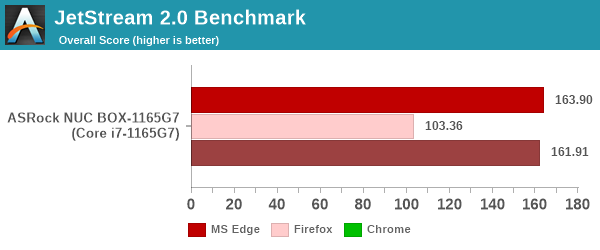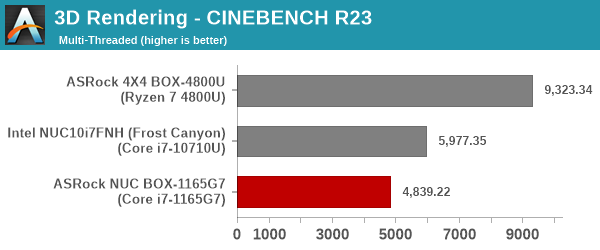ASRock Industrial NUC BOX-1165G7 Mini-PC Review: An Ultra-Compact Tiger Lake Desktop
by Ganesh T S on August 26, 2021 8:15 AM EST- Posted in
- Systems
- Intel
- NUC
- UCFF
- Willow Cove
- ASRock Industrial
- Tiger Lake-U
Miscellaneous Performance Metrics
This section looks at some of the other commonly used benchmarks representative of the performance of specific real-world applications.
Web Browser Benchmarks - JetStream and Speedometer
Web browser-based workloads have emerged as a major component of the typical home and business PC usage scenarios. Beginning with this review, we are including browser-focused benchmarks from the WebKit developers. Hosted at BrowserBench, JetStream 2.0 benchmarks JavaScript and WebAssembly performance, while Speedometer measures web application responsiveness. We also process MotionMark, but the confidence level of the results vary as much as +/-35%. Hence, we present only the Jetstream 2.0 and Speedometer results for the three top browsers below.


In order to maintain reproducibility, we self-host the BrowserBench benchmarks (git clone of the WebKit repository as on July 1, 2021). The browser versions used for the numbers above are presented in the table included in each system's review. Since this is a new benchmark in the suite, the tables for all systems presented in the graphs above are given below.
| ASRock NUC BOX-1165G7 Browser Bench | |||
| Speedometer 2.0 | JetStream 2.0 | MotionMark 1.2 | |
| Microsoft Edge (92.0.902.55) |
140 ± 2.1 | 163.900 | 693.27 ± 16.57% |
| Google Chrome (92.0.4515.107) |
164 ± 3.2 | 161.907 | 813.50 ± 2.29% |
| Mozilla Firefox (90.0.2.7872) |
137 ± 3.0 | 103.359 | 619.00 ± 10.70% |
BAPCo's SYSmark 25 and UL's PCMark benchmarks both include web browser activitites as part of their evaluation scheme. However, the performance for this increasingly important workload tends to get lost in the presentation of a single number. JetStream and Speedometer help us focus on how different PC configurations vary in terms of the user experience with respect to web browsers.
3D Rendering - CINEBENCH R23
We use CINEBENCH R23 for 3D rendering evaluation. R23 provides two benchmark modes - single threaded and multi-threaded. Evaluation of different PC configurations in both supported modes provided us the following results.


Multi-threaded performance suffers when compared against the AMD Renoir offering, and even against Intel's own hexa-core CML-U-based Frost Canyon NUC. However, single-threaded performance is a clear win for the TGL-U mini-PC.
x265 Benchmark
Next up, we have some video encoding benchmarks using x265 v2.8. The appropriate encoder executable is chosen based on the supported CPU features. In the first case, we encode 600 1080p YUV 4:2:0 frames into a 1080p30 HEVC Main-profile compatible video stream at 1 Mbps and record the average number of frames encoded per second.

Our second test case is 1200 4K YUV 4:2:0 frames getting encoded into a 4Kp60 HEVC Main10-profile video stream at 35 Mbps. The encoding FPS is recorded.

This is purely a multi-threaded benchmark, and the 4C/8T TGL-U can't hold a torch to the 6C/12T CML-U or the 8C/16T Renoir APU in the Frost Canyon NUC and the 4X4 BOX-4800U respectively.
7-Zip
7-Zip is a very effective and efficient compression program, often beating out OpenCL accelerated commercial programs in benchmarks even while using just the CPU power. 7-Zip has a benchmarking program that provides tons of details regarding the underlying CPU's efficiency. In this subsection, we are interested in the compression and decompression rates when utilizing all the available threads for the LZMA algorithm.


This is again a test of multi-threading performance, and the TGL-U mini-PC comes in the middle of the pack.
Cryptography Benchmarks
Cryptography has become an indispensable part of our interaction with computing systems. Almost all modern systems have some sort of hardware-acceleration for making cryptographic operations faster and more power efficient. In this sub-section, we look at two different real-world applications that may make use of this acceleration.
BitLocker is a Windows features that encrypts entire disk volumes. While drives that offer encryption capabilities are dealt with using that feature, most legacy systems and external drives have to use the host system implementation. Windows has no direct benchmark for BitLocker. However, we cooked up a BitLocker operation sequence to determine the adeptness of the system at handling BitLocker operations. We start off with a 2.5GB RAM drive in which a 2GB VHD (virtual hard disk) is created. This VHD is then mounted, and BitLocker is enabled on the volume. Once the BitLocker encryption process gets done, BitLocker is disabled. This triggers a decryption process. The times taken to complete the encryption and decryption are recorded. This process is repeated 25 times, and the average of the last 20 iterations is graphed below.


The lack of cores mean that the encryption rate in the TGL-U mini-PC is limited compared to the other systems.
Creation of secure archives is best done through the use of AES-256 as the encryption method while password protecting ZIP files. We re-use the benchmark mode of 7-Zip to determine the AES256-CBC encryption and decryption rates using pure software as well as AES-NI. Note that the 7-Zip benchmark uses a 48KB buffer for this purpose.


Despite slightly higher decryption performance (similar to what we saw for the BitLocker decryption benchmark), the lack of cores mean that the Frost Canyon NUC and the Renoir mini-PC both perform better for dealing with encrypted archives.
Yet another cryptography application is secure network communication. OpenSSL can take advantage of the acceleration provided by the host system to make operations faster. It also has a benchmark mode that can use varying buffer sizes. We recorded the processing rate for a 8KB buffer using the hardware-accelerated AES256-CBC-HAC-SHA1 feature.


Finally, we see one cryptography benchmark where TGL-U comes out as the undoubted leader. This takes away nothing from the fact that the 4C/8T configuration of the Core i7-1165G7 acts as a detriment across many common consumer workloads.
Agisoft Photoscan
Agisoft PhotoScan is a commercial program that converts 2D images into 3D point maps, meshes and textures. The program designers sent us a command line version in order to evaluate the efficiency of various systems that go under our review scanner. The command line version has two benchmark modes, one using the CPU and the other using both the CPU and GPU (via OpenCL). We present the results from our evaluation using the CPU mode only. The benchmark (v1.3) takes 84 photographs and does four stages of computation:
- Stage 1: Align Photographs (capable of OpenCL acceleration)
- Stage 2: Build Point Cloud (capable of OpenCL acceleration)
- Stage 3: Build Mesh
- Stage 4: Build Textures
We record the time taken for each stage. Since various elements of the software are single threaded, and others multithreaded, it is interesting to record the effects of CPU generations, speeds, number of cores, and DRAM parameters using this software.




Better single-threaded performance is no match for the additional cores that Photoscan is able to utilize to shorten the processing time in multiple stages.
Dolphin Emulator
Wrapping up our application benchmark numbers is the new Dolphin Emulator (v5) benchmark mode results.

The single-threaded performance advantage for Tiger Lake enables the NUC BOX-1165G7 to complete the Dolphin emulator benchmark faster than any of the other systems it is being compared against.










33 Comments
View All Comments
dullard - Friday, August 27, 2021 - link
1) "Asrock Industrial" is the name of the company.2) The thing that most defines industrial computers is the promise to keep parts and productions for longer than most other computers. If you buy a Dell home computer, it might have a randomly selected hard drive or memory that differs each time you order it. If you buy a Dell business computer, you might get the same hard drive or same memory for a couple years. Many industrial computers have the exact same parts guaranteed to be in production for often up to 7 years. That really matters when you put in a fortune into equipment and another fortune into qualification of that equipment and suddenly the computer goes down.
Fanless is nice, but certainly not the biggest industrial need.
zsdersw - Monday, August 30, 2021 - link
If it's not fanless and rugged it's not "industrial", as its components won't last as long (dust and other particulates in the air are never good for electronics). Using a computer in an industrial environment commands a level of ruggedness that you won't find in any computer fan.dullard - Monday, August 30, 2021 - link
There are plenty of industries that are not filthy.mode_13h - Tuesday, August 31, 2021 - link
Yeah, exactly. There are applications like kiosks, point-of-sale, and backroom appliances.zsdersw - Tuesday, August 31, 2021 - link
All of which benefit from fanless computers. Dust is everywhere and always bad for electronics.dullard - Tuesday, August 31, 2021 - link
Dust can also collect on fins on fanless computers and render their cooling worse. It isn't a concept of "works" vs "doesn't work".zsdersw - Wednesday, September 1, 2021 - link
It can, but with nothing to draw dust inside the computer it doesn't happen to a noticeable degree over the time between when the computer is deployed and when it's obsolete.mode_13h - Tuesday, September 21, 2021 - link
> with nothing to draw dust inside the computer it doesn't happen to a noticeable degree> over the time between when the computer is deployed and when it's obsolete.
That's not necessarily true. It depends on how prone the enclosure is to collecting dust, the orientation in which it's mounted, how much dust is in the environment where it's used, and how long it remains in service. It's not uncommon for machines to have a service life of close to a decade.
Yes, we can agree that fanless is the better option, if you're at all worried about dust. Whoever wants this SFF "industrial" PC must care more about size and performance than maintenance costs.
Manvadher - Friday, August 27, 2021 - link
I really love this site and its reviews but why did you do this"The NUC-1165G7 places the 4.09" x 4.02" motherboard inside a chassis measuring 110 mm x 117.5 mm x 47.85 mm"
Two different units in the same sentence!
Either way thank you for the review!
ganeshts - Monday, August 30, 2021 - link
The 4x4 and 5x5 are recognized stand-ins for the NUC and mini-STX form-factors respectively, and I was using the imperial measurements to convey that this is a standard NUC board. I have since edited the piece to add the SI measurements also for the motherboard dimensions.